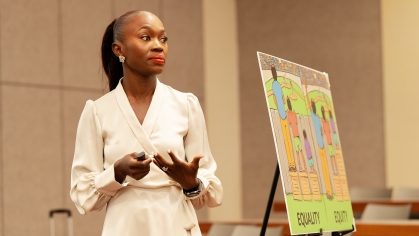The Rutgers Board of Governors today approved the merger of the two Rutgers law schools into one unified law school with two distinct locations in Camden and Newark, contingent upon approval by the American Bar Association.
Poised to be a leader in legal education in the Northeast and among the nation’s public law schools, Rutgers Law School will deliver a comprehensive curriculum enhanced by technology, offering exceptional breadth and depth in theory, practice, and interdisciplinary courses; an alumni network spanning two of the five largest legal markets in the nation; a strong tradition of diversity and social impact; and a higher national profile to attract top students. An integrated Rutgers Law School would begin using a single application in the fall of 2015 for the 2016 entering class.
“This merger represents an unprecedented and ambitious play in legal education,” says Rutgers Law–Camden Acting Dean John Oberdiek. “We believe strongly under this new model, that there are increased opportunities for students at each location to advance their career searches and to learn from and with a wider selection of world-class Rutgers faculty. Rutgers Law School will be greater than the sum of its parts and will strengthen the reputation of a Rutgers legal education.”
“Rutgers Law School will be uniquely situated to be able to draw upon the strengths and clarity of mission of Rutgers University–Newark, Rutgers University–Camden, and the entire Rutgers system, to provide an exceptional legal education to our students, promote publicly engaged scholarship by which to use the law as an instrument of positive social change, and foster interdisciplinary collaboration with all our Rutgers colleagues,” says Acting Rutgers Law–Newark Dean Ronald K. Chen. “At this defining moment for legal education and for the legal profession, the unification of Rutgers Law will enable us to advance all those goals with a new energy.”
Rutgers Law School will employ a robust faculty of 100 scholars, with particular strengths in criminal law, intellectual property, corporate and business law, health law, and public interest law, but all advancing a comprehensive curriculum facilitated by state-of-the-art technology. With more than 1,000 students drawn from across the country, Rutgers Law School will also be among the nation’s largest law schools, yet it will boast a student-faculty ratio on par with other leading public law schools.
A concept to reunify – the schools were first separated into two Rutgers entities, with their own accreditation, faculty, and curricula in 1967 – was first introduced by law school leadership in 2011. Two co-deans, reporting to chancellors at each university in Camden and Newark, will lead the merged Rutgers Law School. The co-deans will maintain their individual lines of authority, reporting to the chancellor of Rutgers University–Newark or of Rutgers University–Camden. They will work with both chancellors and also work collaboratively with the university senior vice-president for academic affairs.
Rutgers President Robert Barchi, who announced the plan for the law schools to merge in 2013, acknowledges this leadership structure to be fitting for the innovative plan, the first of its kind in recent history.
“For more than a century, Rutgers has delivered leading-edge legal education to New Jersey. Within that context, it makes perfect sense that Rutgers is again at the forefront of innovative best practices by combining the unique strengths of our law schools in Newark and Camden into one school with an impressive range of opportunities for its students and a national profile that rests in the achievements of its faculty and its alumni,” says Barchi. “Rutgers University–Camden and Rutgers University–Newark will benefit from what we anticipate will be greater demand for a Rutgers Law degree.”
The host cities of the two locations of Rutgers Law School remain vital to the various clinical, pro bono, and other skills-based offerings that already bring the law schools in Newark and Camden national recognition. Few law schools around the nation will be able to offer the variety of clinical and other experiential learning opportunities that will be available to Rutgers Law School students. In addition, the merger will enable students to pursue a greater diversity of careers beyond the traditional practice of law than students at most peer schools.
Says Rutgers University–Camden Chancellor Phoebe A. Haddon, “Partnership and collaboration represent the future of legal education, and this merger of Rutgers’ law schools represents something as yet unseen in our nation’s rapidly changing law school environment: two schools, each with distinctive, yet equal, strengths, coming together to create a comprehensive law school with extraordinary opportunities for learning experiences and career growth. The continued strong presence of Rutgers Law in Camden and in Newark will assure that both institutions are able to build upon their unique characteristics to better serve their host cities and regions, as well as all of New Jersey and the nation.” A member of the American Bar Association’s Commission on the Future of Legal Services, Haddon has been named among the “25 Most Influential People in Legal Education” by National Jurist magazine for three years. She has served on the Council of the American Bar Association Section on Legal Education and Admission to the Bar, the official accrediting body of U.S. law schools.
Rutgers University–Newark Chancellor Nancy Cantor sees the merger as an important mechanism for also fostering high-impact scholarship. “Many of the most complex challenges facing Newark and Camden—indeed, legacy cities and their metropolitan areas everywhere—require an all-hands-on-deck approach that integrates the perspectives of legal scholars, practicing attorneys, and the broader community of experts including scholars and professionals across other fields, public officials, nonprofit leaders, and community members. The new Rutgers Law School configuration increases the potential impact of our faculty, staff, and students by broadening and deepening the reach of these communities of experts.”
New distance-learning technology in use for five courses this spring is already uniting the two locations and bringing a sense of common identity to faculty and students separated by 90 miles. Moving forward, Newark and Camden’s state-of-the-art immersive distance education will offer a full suite of courses, giving the merged Rutgers Law School among the most comprehensive curriculums in the nation.
The creation of the Rutgers University Law Review is another milestone achieved during the merger process. After decades of producing separate flagship journals, Camden’s Rutgers Law Journal and Newark’s Rutgers Law Review, this newly merged publication will debut this spring as Rutgers Law School’s flagship journal, jointly run by students from both locations.


